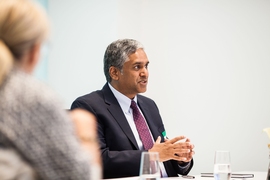MIT and IBM jointly announced today a 10-year agreement to create the MIT–IBM Watson AI Lab, a new collaboration for research on the frontiers of artificial intelligence. Anantha Chandrakasan, the dean of MIT’s School of Engineering, who led MIT’s work in forging the agreement, sat down with MIT News to discuss the new lab.
Q: What does the new collaboration make possible?
A: AI is everywhere. It’s used in just about every domain you can think of and is central to diverse fields, from image and speech recognition, to machine learning for disease detection, to drug discovery, to financial modeling for global trade.
This new collaboration will bring together researchers working on the core algorithms and devices that make such applications possible, enabling the pursuit of jointly defined projects. We will focus on basic research and applications, but with new resources and colleagues and tremendous access to real-world data and computational power.
The project will support many different pursuits, from scholarship, to the licensing of technology, to the release of open-source material, to the creation of startups. We hope to use this new lab as a template for many other interactions with industry.
We’ll issue a call for proposals to all researchers at MIT soon; this new lab will hope to attract interest from all five schools. I’ll co-chair the lab alongside Dario Gil, IBM Research VP of AI and IBM Q, and Dario and I will name co-directors from MIT and IBM soon.
Q: What are the key areas of research that this lab will focus on?
A: The main areas of focus are AI algorithms, the application of AI to industries (such as biomedicine and cybersecurity), the physics of AI, and ways to use AI to advance shared prosperity.
The core AI theme will focus on not only advancing deep-learning algorithms and other approaches, but also the use of AI to understand and enhance human intelligence. One of the goals is to build machine learning and AI systems that excel at both narrow tasks and the human skills of discovery and explanation. In terms of applications, there are some particular targets we have in mind, including being able to detect cancer (e.g., by using AI with imaging in radiology to automatically detect breast cancer) well before we do now.
This new collaboration will also provide a framework for aggregating knowledge from different domains. For example, a method that we use for cancer detection might also be useful in detecting other diseases, or the tools we develop to enable this might end up being useful in a non-biomedical context.
The work on the physics of AI will include quantum computing and new kinds of materials, devices, and architectures that will support machine-learning hardware. This will require innovations not only in the way that we think about algorithms and systems, but also at the physical level of devices and materials at the nanoscale.
To that end, IBM will become a founding member of MIT.nano, our new nanotechnology research, fabrication, and imaging facility that is set to open in the summer of 2018.
Lastly, researchers will explore how AI can increase prosperity broadly. They will also develop approaches to mitigate data bias and to ensure that AI systems behave ethically when deployed.
Q: What effect do you expect this collaboration will have on students and faculty here at MIT?
A: Above all, the lab will foster collaboration. There will be new projects among MIT researchers and between MIT and IBM researchers. And because the collaboration will also provide more opportunities for students to be involved in advanced research, through programs such as MIT’s Undergraduate Research Opportunities Program (UROP), the benefits of this relationship will extend across campus.
In addition to the new work, we have a lot of ongoing research that we will be able to leverage. Investigators in the Computer Science and Artificial Intelligence Laboratory (CSAIL), the Department of Brain and Cognitive Sciences (BCS), the Media Lab, and the Institute for Data, Systems, and Society (IDSS) are all actively working in AI already. The new lab presents an opportunity to bring them closer together.
This collaboration is positioned to help the creation of startups, in connection with The Engine, MIT’s new venture firm. We also anticipate making connections between the lab and on-campus innovation programs such as the Deshpande Center for Technological Innovation, MIT Sandbox, and the Martin Trust Center for MIT Entrepreneurship, spurring broader commercialization opportunities. This could ultimately help the creation of jobs in the Boston area and support a very strong AI ecosystem, both locally and nationally.











